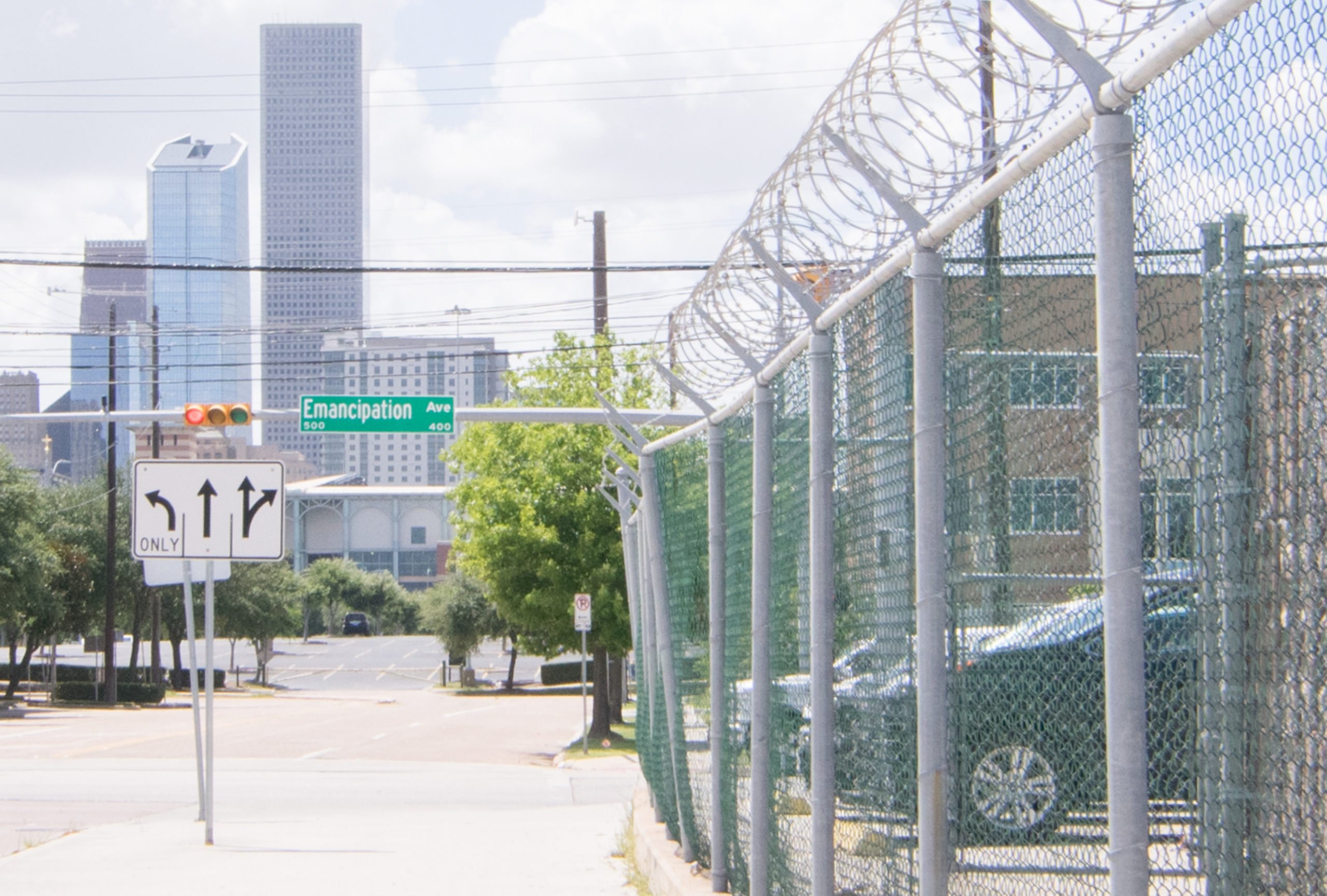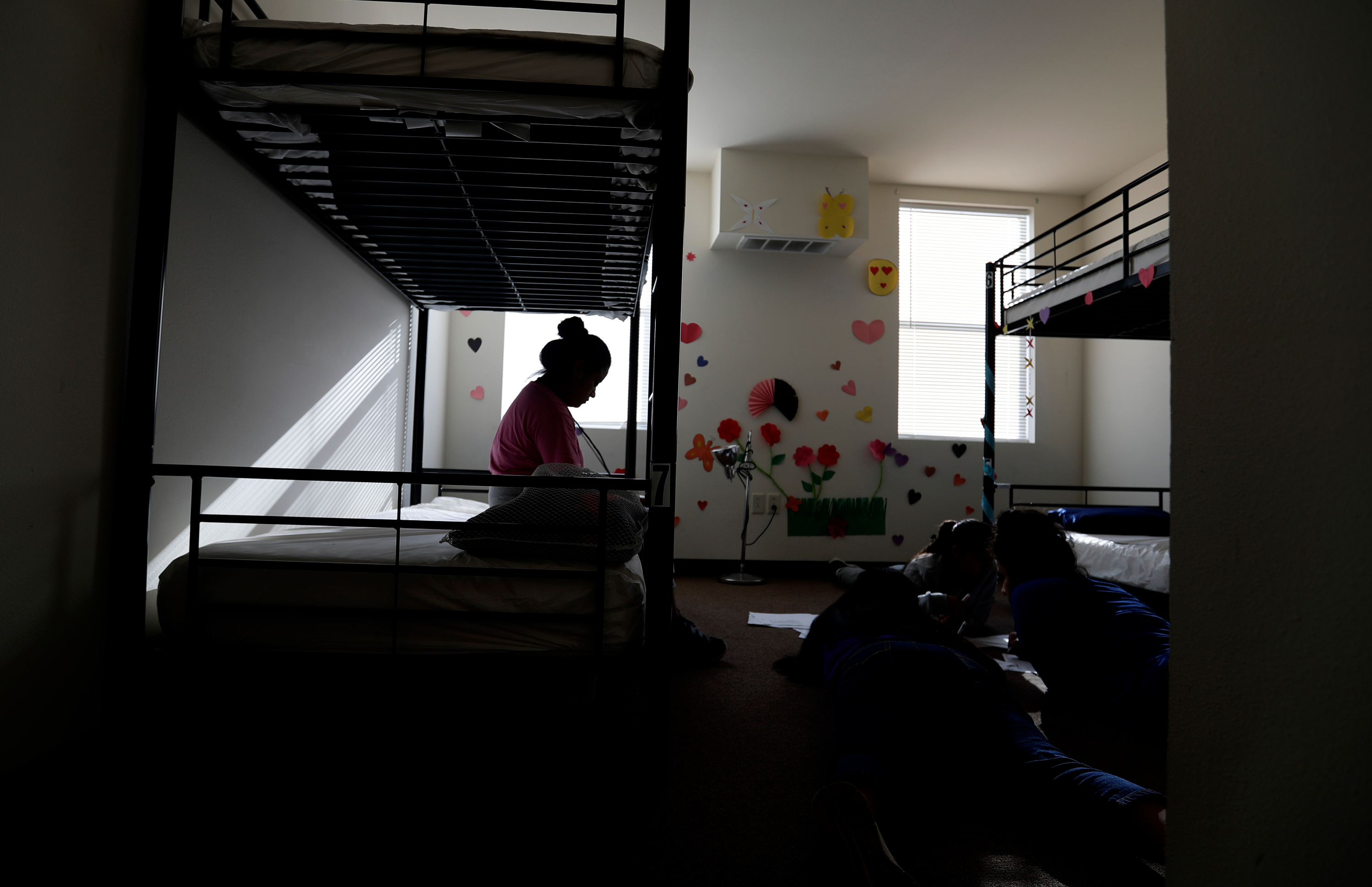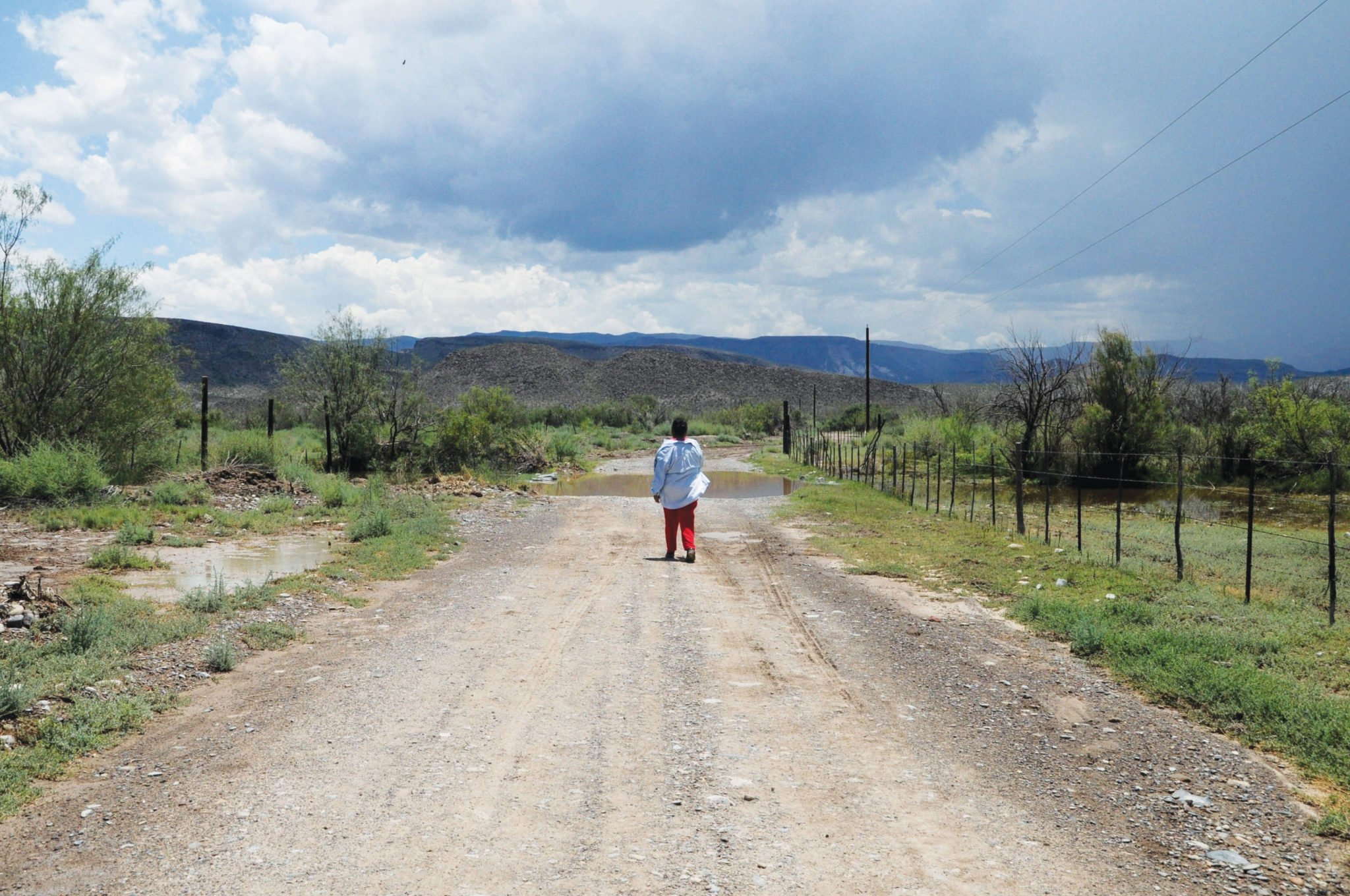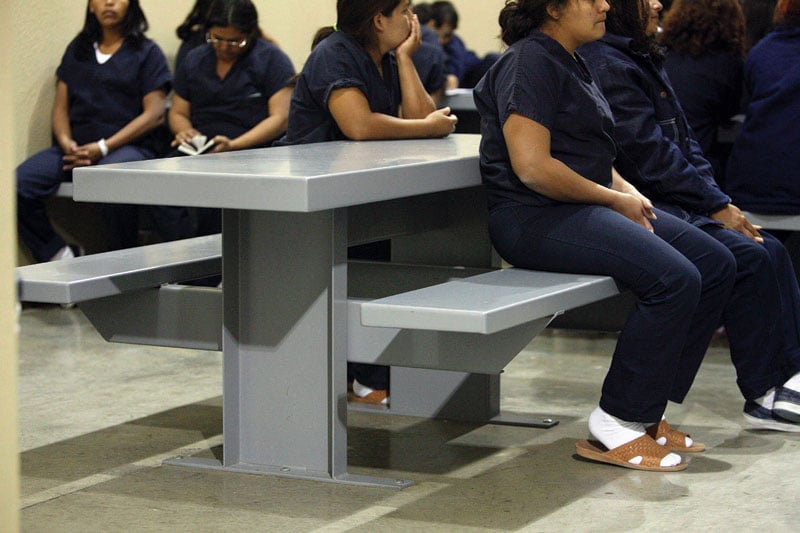
Give Us Your Tired, Your Poor, Your Huddled Masses—We Have Private Prisons to Fill
The profits and losses of criminalizing immigrants.

A version of this story ran in the May 2013 issue.
Above: Immigrant female detainees inside their holding cell of the Willacy County Immigration Detention Center in Raymondville.
When Jose Rios walked into a Bank of America branch last year, he hoped to open an account for the car repair shop he owned. He didn’t expect to end up with a prison sentence.
Days after Rios provided the bank with a home address and Social Security number, Immigration and Customs Enforcement (ICE) agents showed up at his house looking for him. (Rios said ICE agents later told him that Bank of America turned him in.) Rios wasn’t home. His wife, a pretty, sad-eyed woman of 38, answered the door.
“They said, ‘if we don’t find [Jose], we come back for you,’” she said, sitting outside her daughters’ elementary school on a gorgeous California day while her smiling 2-year-old brought us handfuls of dainty red geraniums. Her daughters, the agents warned, could end up in foster care.
Both Jose and his wife, Marta, are undocumented immigrants. (The Observer has changed their names to protect their identities.) Their three girls—ages 2, 7 and 12—are U.S. citizens. Facing the prospect of a shattered family, Jose turned himself in to ICE.
In an audition for a model undocumented immigrant, Rios, 34, probably wouldn’t make the final cut. His parents brought him and his two brothers to California from Mexico when Jose was 3. He graduated from high school in Fresno, a rough-around-the-edges city in California’s Central Valley. Rios had a green card until, in 2000 at age 21, he was caught with 35 pounds of marijuana in San Diego and charged with possession with intent to sell. He spent 37 days in jail, was stripped of his green card and sent to Mexico, a country he hardly knew. That same year he and Marta married; she was pregnant with their first child. There was no way he was staying in Mexico. “I don’t have nothing in Mexico,” he says. “My brothers, my sisters and parents, my wife and my daughters are in California.”
In the estimation of the federal government, Rios is a “criminal alien.” When he was caught with that marijuana, he lost his legal claim to his adopted country. He became a double-outcast: an unauthorized immigrant with a criminal record.
In the simplest terms, he is a “criminal alien” and convicted drug smuggler. But that simple narrative leaves out key details of his life: He has three U.S. citizen daughters, the oldest of whom plays in a school mariachi band, serves on student council, is an ‘A’ student, and seems bound for success. It doesn’t include his decision—after his initial drug conviction—to become a confidential informant for a California police department, helping put together drug busts that swept dealers off the streets. It ignores his skills as a welder and mechanic, and his successful small business. It doesn’t include his turning to God; the Rioses are churchgoing Pentecostals. Jose plays bajo sexto, piano and guitar in the church band.
Rios says he’s been paying for his mistake repeatedly. “It was a one-time deal,” he says of his drug conviction. “I was going through a rough time. I saw the opportunity for some money, and I went through with it. It was a big mistake; I’ve been suffering the consequences from that ever since.”
For years, Rios, despite his illegal status, managed to lay low. But in 2006, he went to work at an auto-body shop owned by a friend. After only a few weeks on the job, the police raided the shop and arrested the owner—who they accused of selling drugs—as well as the employees. (Jose says he was ignorant of what was going on.) While Rios was sitting in jail, a Fresno cop paid him a visit. He asked if Rios would work as a confidential informant. The deal, as Rios understood it, was that he’d help the cops arrange drug busts, and in exchange they would get him a special visa. He’d snitch his way to freedom.
But the narcotics unit imploded before Rios got his visa. Several officers were arrested on charges that they had stolen a car from a suspected drug dealer.
“They dropped all the [confidential informants],” he says. “I was stuck right there. I didn’t know what to do.” In 2010, Rios was pulled over, he says, for a missing light on his license plate. He was arrested and sent to Mexico again.
Rios was back in Fresno within two weeks, playing with his little girls at the house with the white wrought-iron fence, the dust from his border crossing still caked to his shoes.
With a growing family, Rios wanted a steady income. He planned to take his experience as a mechanic and his enviable collection of tools and start his own auto-body shop. That led him to Bank of America, and into the hands of the criminal justice system.
Rios had been detained before, of course, but this time U.S. officials handled his case differently. In 2005, the Bush administration had instituted a key policy change: Instead of simply detaining undocumented immigrants who have done nothing more than cross the border and sending them out of the country or releasing them, the U.S. government would now file criminal charges and send them to prison. Rios was charged with illegal re-entry, a federal immigration felony that earned him a 14-month sentence, much of it spent in a notorious private prison in South Texas. Rios pleaded guilty, as do 97 percent of all immigration-related defendants.
Since 2005, immigration has been criminalized as never before. In 2000, when George W. Bush came into office, there were about 10,000 convictions for illegal entry and re-entry—essentially crossing the border illegally; in 2011, even as the number of people crossing the border had plummeted during the Obama administration, there were more than 71,000 such convictions—a 700 percent increase. Immigration is now the most-prosecuted federal crime, surpassing weapons, white-collar crimes and even drugs. Locking up unprecedented numbers of immigrants has swelled the federal prison system. New prisons are being constructed at a rapid pace, most of them privately run. Unlike the rest of the Federal Bureau of Prisons system, prisons for immigrants are completely privatized. So while the mass criminalization of immigrants has torn parents from their families, removed skilled people from the workforce and had a debatable impact on border security, the policy has served one interest very well—private-prison companies.
Operation Streamline sounds innocuous compared to its militaristic cousins from the past: Operation Hold the Line, Operation Endgame and Operation Wetback. But Streamline, launched in 2005 in Del Rio, Texas, may be the most ambitious. ICE has adopted Operation Streamline in some form along the U.S.-Mexico border, except in California. It’s a “zero-tolerance” policy aimed at securing a criminal conviction for every undocumented immigrant apprehended on the border. No exceptions. Operation Streamline is the most visible program, but it applies only to immigrants captured on the border—and it’s just part of America’s move to criminalize immigrants anywhere in the country. Rios was captured hundreds of miles from the border—and wasn’t subject to Operation Streamline—but he too was prosecuted and imprisoned. Between 2005 and 2011, more than 376,000 convictions for illegal entry and illegal re-entry were secured.
The policy changes, Operation Streamline included, were perhaps born of frustration. Prior to the program, the Department of Homeland Security would either quickly return unauthorized immigrants to their home countries or put them into the civil immigration system, where they could appear before an immigration judge. However, with a boom in Border Patrol agents and a steady stream of migrants across the border, the existing immigrant detention centers filled up. That meant authorities had to resort to “catch and release” for so-called Other than Mexican immigrants, who would receive a notice to appear in front of a civil immigration judge and then be released. Few bothered to show up. Operation Streamline virtually eliminated “catch and release” by moving migrants from the civil immigration and detention system into the criminal justice system. But now the criminal side is also feeling the strain.
Federal courts, especially those in border districts, are now overrun with immigration cases. Both first-time border crossers and unauthorized immigrants with deep ties to the U.S. are getting swept up.
Immigration attorneys, advocates and undocumented immigrants themselves have nothing but scorn for the program. “I think it’s useless and a waste of my tax dollars, and on some level just reprehensible to be punishing people for wanting to work and feed their families,” says Dan Kowalski, a prominent immigration attorney in Austin. He doesn’t think the program offers much deterrent, either. “I analogize to the Berlin Wall. People were shot and killed trying to get over, under, through or around the Berlin Wall for something as abstract as political freedom. When you’re dealing with something as concrete as hunger, you’re going to go through bullets, barbed wire and fences.”
Sitting judges have occasionally taken a similar, if not quite as strident, line. “This court has yet to find an adequate sentence that will act as a deterrent for those re-entering the country illegally,” said federal District Judge Lee Yeakel, a Bush appointee who serves in Austin, at a sentencing hearing.
The government hoped to deter repeat crossers by devising a scheme of escalating punishment. While most first-time border crossers receive an illegal entry charge, carrying a maximum of 180 days in jail, those caught crossing again after a deportation can face illegal re-entry charges, which carry to a two-year penalty. Those with a felony already on their record, like Jose Rios, could be looking at 10 years.
But the deterrent effect has its limits, as evidenced by the surge of illegal re-entry cases. Immigrants like Rios, with a family and career in the United States, won’t be deterred from crossing the border again—no matter how stiff the potential penalties.
The immigration bill working its way through Congress would dramatically increase these penalties. It would double the maximum jail time for the most basic cases—your run-of-the-mill border hopper—from six months to a year in jail. Those with a criminal record, even for minor crimes or immigration-related cases, would be punished even more severely.
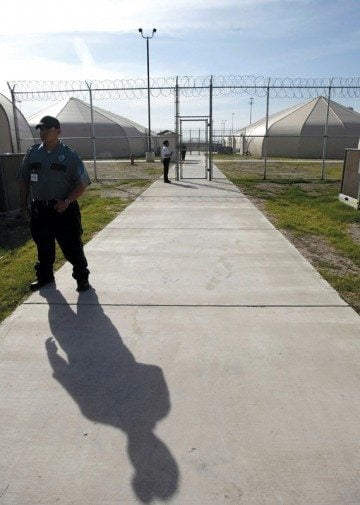
It’s a sunny spring Tuesday in Del Rio, and that means the mesquite trees are leafing, the glittery bass boats are plying nearby Lake Amistad, and a lot of people are wading the Rio Grande. It also means U.S. Magistrate Judge Victor Roberto Garcia’s courtroom is packed with Operation Streamline defendants. The first thing you notice about the courtroom is that there’s little room to sit. The defendants take up almost every available spot, including the jury box and the rows of benches for observers (I’m the only spectator who’s not a court employee, attorney, Border Patrol agent or U.S. Marshal).
Today is not unusual: 115 defendants facing illegal-entry charges, 38 in the morning and 77 in the afternoon. In 2012, the Western District of Texas, which includes Del Rio, handled 18,700 immigration-related convictions, constituting 85 percent of all cases. Drugs came in a distant second at 10 percent. Compared to most of the Bush years, Barack Obama’s administration has quadrupled the number of immigrant prosecutions.
The shackled defendants, fresh from the GEO Group-operated Maverick County Jail, are dressed in orange jumpsuits, slippers and surgical masks, so freshly apprehended that they have yet to go through a screening for tuberculosis and other diseases. Court personnel pass around a squirt-bottle of hand sanitizer.
Things get started late in the morning due to a paperwork snafu. Apparently, GEO Group has failed to bus over 22 of the defendants. The jail is an hour away—a headache for the defense attorneys—so that group gets bumped to later in the afternoon. “They’re a contract company,” complains one of the court employees. “They’re working for us.”
The defendants are all from Mexico and Central America, mostly first-time crossers in search of work or trying to reunite with their families. Only a handful have criminal records.
Their court-appointed attorneys have spent a few minutes interviewing them the evening before, enough time to look for a thread of a defense and gather some biographical details. Today, the morning group will be arraigned, pleaded and sentenced in one hour—a ruthless efficiency that some constitutional law scholars say violates due process.
It goes like this: The judge explains to the group that they’ve been charged with illegally crossing into the U.S. and that they face up to six months in jail. Then he asks a battery of questions. “Do you want to plead guilty, yes or no?” One by one, each person says: “Culpable” (“guilty”). Almost no one ever pleads “not guilty” or goes to trial.
Then the judge takes up the cases. The prosecutor, who is actually an attorney for the Border Patrol, reads a basic statement alleging that the defendant entered unlawfully by “wading across the Rio Grande River.” The defense attorney’s role is more or less to explain that so-and-so entered the country to work or to be with family, to plead with the court for mercy. Matlock it isn’t. For example, the attorney explains in U.S.A. vs Sergio Moncada-Cardenas that the English-speaking 18-year-old had lived in the U.S. since he was 2. His mother is dead, and his father is in prison. He’d been in Mexico only a week before he attempted to come back and got picked up.
The judge says, “We’re not saying you’re a bad person. But you do not have permission to enter.” He then explains that there is “a movement” to allow people like Moncada-Cardenas to get some legal status. “You’re not going to get it if you keep crossing illegally,” the judge says. He sentences Moncada-Cardenas to 10 days.
But as Kowalski, the Austin immigration attorney, later pointed out to me, it’s extremely difficult for a Mexican to obtain a visa, and criminal convictions generally mean you’re banned from even applying for years.
But the judge’s message is clear: do not come back or you will face more prison time. “No more catch and release, understand?” he says to one man who’d been previously convicted of illegal entry and deported. In only one instance did the judge hand out a reduced sentence. The morning session lasts all of an hour.
“Streamline is unlike anything I’ve seen in any district I’ve practiced in,” says Joseph Cordova, the head public defender in Del Rio. “It is mind-numbing. Our job is to try to humanize our clients as much as possible.
“Sometimes,” he says, “we are just tilting at windmills, but every once in a while we get that nugget where the judge says, ‘You’re right.’”
Collectively, the 115 people convicted this day will serve 12 years in prison with an average sentence of 39 days. While incarcerated, they will generate about $320,000 for a private-prison company.
In August 2006, George W. Bush came to the Rio Grande Valley to brag on his border crackdown. Bush promised more Border Patrol agents and an end to “catch and release,” which he called an “unacceptable practice.”
“Step one is to add detention beds. If you didn’t have enough detention space in the first place, the way you solve the problem is you add beds.
The prison boom was well underway. The day before Bush’s announcement, a 2,000-bed detention center had opened in Raymondville, an economically depressed town half an hour north of Brownsville. The $60 million detention center had been hastily erected in 45 days amid a bribery scandal that sent three county commissioners to prison. The Willacy Detention Center quickly earned the moniker “Tent City” for its peculiar “sprung structure” design: Ten cavernous buildings composed of a Kevlar-like material stretched over a steel frame. Each “tent” has four pods, which are smaller than a basketball court and contain 50 detainees each. They were supposed to be temporary.
Every aspect of Tent City—its design, construction, financing and operation—was privatized, save one. Willacy County would take on the debt.
Tent City quickly became a symbol of ICE’s inhumane treatment of immigrant detainees. Human rights advocates pointed out the people warehoused at Willacy weren’t in criminal custody. They weren’t being punished, and many had legitimate claims to stay in the U.S. They were in civil detention, not prison.
A full accounting of the detention center’s sorry record would run too many pages: sexual assaults, maggots in the food, inattention to serious medical problems, limited access to lawyers, beatings of detainees. A 2011 PBS Frontline documentary uncovered a “dozen allegations of sexual abuse”—a finding that helped spark 13 separate criminal investigations by the Department of Homeland Security.
“The level of human suffering was just unbelievable,” Kathleen Baldoni, a nurse who had worked at Willacy, told a congressional panel in 2009.
The image of a South Texas detention colony for immigrants didn’t exactly fit the Obama administration’s pledge to create a “truly civil detention system.” In the summer of 2011, as the Frontline documentary was set to air, the Obama administration announced that it would be pulling detainees out of Willacy. But they didn’t take down the tents.
Instead, the Obama administration quietly converted Tent City from an ICE detention center into a Bureau of Prisons facility. Suddenly it was part of the criminal system. But two things remain the same: The private prison company MTC continues to operate the detention-center-turned-prison, and the inmate population—non-violent undocumented immigrants from Mexico and Central America—is largely the same. “I would say the only thing that’s changed is there is now a lack of focus on it, there isn’t the oversight,” said Mark Fleming, who helped author a 2011 report on American immigrant detention facilities for the Inter-American Commission on Human Rights.
“I think it represents a shift in policy toward the mass prosecution of immigrants on top of the civil detention system,” said Bob Libal, the executive director of Grassroots Leadership, an Austin-based group that opposes private prisons. The Bureau of Prisons, Libal said, “receives far less scrutiny than ICE, and there is no indication that the BOP is going to change the way that facility operates.”
Traditionally, the Bureau of Prisons has run its own facilities, but if you’re a low-security immigrant you’re almost certainly going to do time in one of 13 privately operated prisons. Just three for-profit companies—Corrections Corporation of America, GEO Group and MTC—control the market for incarcerating “criminal aliens.”
Six of these private prisons are located in Texas. Their hosts: impoverished rural communities desperate for the jobs.
These prisons house mostly individuals sentenced for immigration crimes. While BOP-run facilities tend to be well-operated with few scandals, private “criminal alien” prisons in Texas and elsewhere have been rocked by riots, corruption scandals, inmate deaths, and cases of inadequate medical care and abuse.
The cost to the taxpayer for incarcerating 70,000 non-citizens for immigration crimes now tops $1 billion a year.
Privately held MTC’s 10-year contract with the federal government is worth up to $532 million. Even better, the Bureau of Prisons pays MTC at least $45 million a year regardless of how many inmates the Raymondville prison is holding. That works out to about $50 per day per inmate.
Although MTC doesn’t file public reports with the Securities and Exchange Commission, its two main competitors, Corrections Corporation of America (CCA) and GEO Group do. In CCA’s most recent annual filing, the company notes that since 2001 the number of federal inmates held in private facilities has surged by nearly 150 percent. An expanding market in federal prisoners is good news for private-prison companies—especially at a time when state prison populations are stagnant or even declining.
As federal lockups grow, so have the companies’ profits. CCA’s revenue has grown 46 percent since 2005. And the company, which runs the Eden Detention Center in Eden, Texas, has managed to wring more out of each of its prisoners. CCA reports that its margins have ballooned 50 percent since 2005, from $12.80 earned per prisoner per day to $18.23. GEO Group’s revenue from its corrections and detention division increased from $572 million in 2005, when the criminalization of immigrants began, to more than $975 million in 2012—a 70 percent increase.
But these good times depend on the continuation of the feds’ lock-’em-up immigration policies. In SEC filings, CCA warns investors that “any changes with respect to drugs and controlled substances or illegal immigration” could “potentially reduce demand for correctional facilities to house them.”
What do federal taxpayers get for more than $1 billion spent on incarcerating immigrants?
The ACLU of Texas spent three years investigating Texas’ immigrant prisons and found what it calls a “two-tiered system of justice” in which non-citizens are corralled into overcrowded, substandard prisons run by private operators with records of misconduct. In a forthcoming report based on interviews with 150 prisoners in four different Texas criminal alien prisons, the ACLU alleges that the segregation of non-citizens, mostly Latinos, within the federal prison system violates prisoners’ constitutional rights.
“When we asked [prisoners] to compare the two, they said the BOP-run facility was heaven and this is hell,” said Krystal Gomez of the ACLU of Texas.
Federally run prisons are no Club Med. But in the agency’s 83-year history, there hasn’t been a single documented riot over poor conditions. There have been three riots in privately operated federal facilities. GEO Group’s enormous Reeves County Detention Center in Pecos was the site of two explosive uprisings in December 2008 and January 2009. (See “The Pecos Insurrection,” Oct. 8, 2009). The first riot was sparked after Jesus Galindo, an epileptic who had begged for medical treatment, was found dead in solitary confinement. The ACLU of Texas has documented nine deaths from suicide or illness at Reeves since 2006.
Jose Rios is coming back to America, with or without the government’s permission. If caught, he could face 20 years in prison.
Since he was deported to Mexico from Willacy in late February, he’s been waiting around in a Mexican border town. In a strange twist, the ICE agent responsible for his illegal re-entry indictment wants him to sign on as an ICE informant. The agent is working to get Rios a visa so he can return legally.
Hector, Jose’s brother, finds the situation both ironic and infuriating.
“If he’s going to be allowed to come back into the country, in reality what was gained? As a society, nothing was gained. As a society, how do we justify that? We’re broke as hell, yet we’re housing these individuals months and years on end, costing the American taxpayer a bajillion dollars.”
The situation for Jose’s family is about what you’d expect. Marta has sold their vehicles and all of Jose’s tools. She lives in fear that at any moment she’s going to get deported too. She says she’s lost 40 to 50 pounds walking everywhere. She’s studying for her GED, taking English classes and tending to her kids. “If I’m busy, I don’t think. If I don’t think, I don’t cry. And if I don’t cry, I’m good,” she says, crying.
Is she hopeful that it will all work out? “I don’t know. I hope in God that he help us, but I don’t know if I trust in the people.”
Rios can tally what he’s lost: Thousands of dollars, his business, seeing his daughters grow up, time with his wife. “I lost everything, bro,” he says. “I lost everything.”
The nation wasn’t discernibly safer for his absence.
But for the private company that imprisoned him for a year, the gain was about $18,000.
Correction: The original version of the story stated that Bank of America had acknowledged a policy of reporting undocumented immigrants to the authorities. Bank of America has not publicly acknowledged such a policy. The Observer regrets the error.
Research for this article was supported by the Fund for Investigative Journalism.
